West Hartford Superintendent Presents ‘Reopening Schools’ Plan to Board

Audio By Carbonatix
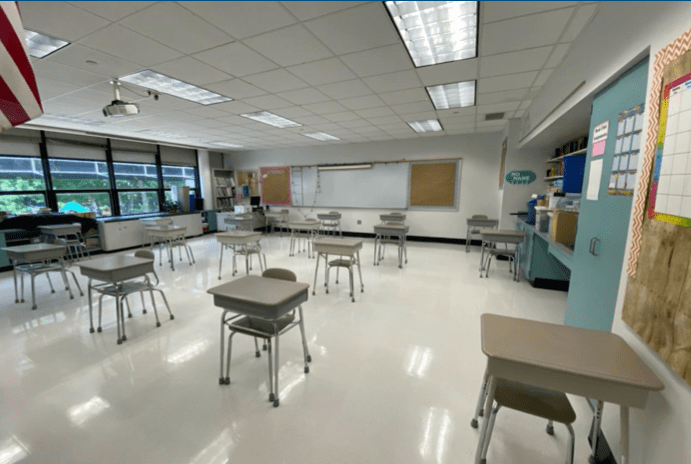
Sample of desk spacing in a West Hartford Public Schools classroom. Courtesy image
The West Hartford Board of Education met Tuesday night for a presentation of the ‘Reopening Schools’ plan and also voted to approve a change to the calendar for the 2020-21 academic year. [Originally published July 22, 2020. Updated July 23 with link to the ‘WHPS Blueprint for Reopening Schools.’]
By Ronni Newton
West Hartford Superintendent Tom Moore has spent the past three weeks overseeing the crafting of a three-part “Reopening Schools” plan, and Tuesday night he and the executive team members explained the details of that plan and responded to questions from Board of Education members at a meeting that ran nearly four hours.
Moore said he received many letters and comments from the community as well as input from other stakeholders as the plan was being developed during the past few weeks – ever since the state gave public school districts the mandate to produce three plans for the upcoming academic year. The governor made an announcement June 25 that students would be welcomed back to school in the fall, followed up by a 50-page plan released by the state Department of Education on June 29 instructing districts to provide options for a return to classrooms, a hybrid plan, and total remote learning.
“The decision to open was not made in a vacuum in West Hartford,” Moore told the Board. His challenge was how to do it as safely as possible.
And while a national discussion continues to take place regarding the safety of students returning to school while the COVID-19 pandemic continues, Connecticut law requires (for this coming year) that access to public school classes be made available for 177 days.
“It’s impossible to talk about this decision to reopen without understanding the emotions involved,” Moore said. “I get the teachers and their fears, and I get parents and their fears. … Please come together and have patience for each other and understand what people are going through,” he urged.
There are people worried about their livelihoods and worried about their health, and all deserve sympathy, and it’s not political, liberal, or conservative. “It’s personal, about mom and dad and kids and teachers and families,” said Moore.
Noting that some who spoke during the public comment session, including members of EDI (Equity, Diversity, and Inclusion group that has been formed at many schools) felt he wasn’t paying attention to their concerns about ensuring the curriculum would include an anti-racism focus going forward, and that all decisions would be viewed through an equity lens, Moore admittedly got a bit defensive. He said that having stakeholders meet with Roszena Haskins, whose title is being changed to “Director of Equity Advancement” (from Director of Diversity Enhancement), rather than with him directly is not a slight “because I listen to everything she says.” Moore also said that he personally receives the responses to communications he sends out, and replies – often at night, or on Saturdays.
Timing has been critical. A survey of families had to be done within a specific timeframe, the state requires the plan that Moore outlined Tuesday to be submitted by Thursday, and the district can’t plan and can’t hire without knowing how many families are planning to send their kids back to school.
Gov. Ned Lamont will make the decision about heading back to school in early August, Moore said.
“We’re going to be in school some day and we are going to welcome kids back some day,” he said after detailing the plan.
“Education is the answer, education is the answer for equity,” said Moore.
The survey
About 75% of West Hartford families responded to the “Learning Intentions Survey” that was sent out July 2 and required completion by July 17. Among the nearly 7,000 responses, 75% indicated that they plan to send their children to school while 8.5% plan on home schooling and 16.5% are uncertain.
As of Tuesday, Moore said the data is still being scrubbed because some families responded multiple times.
The complete 44-page “WHPS Blueprint for Reopening Schools” was distributed to families via email on Thursday. It is available in multiple languages, and can be read in PDF or flip book format and is available here on the West Hartford Public Schools website.
“The 2020-2021 school year will be like no other, but West Hartford’s schools will continue to be models for our state and nation, whether they are brick and mortar or online,” Moore said in his email to families on Thursday.
The community has the opportunity to provide feedback on what is a “living document.” The FAQ section will continue to be updated, Moore said.
In addition, principals from each school will be reaching out to families, and those who initially said they were unsure or did not reply to the survey are being asked to indicate by Aug. 3 what their plans are for the coming year.
The survey was not about whether parents or teachers want schools to reopen because that is up to Gov. Lamont, Moore said. The survey was needed so the district could populate classes.
Guiding principles
The overall plan has multiple layers, all of which are based on student, staff, and community safety, Moore said.
Additional guiding principles are: providing an equitable educational opportunity for all students through onsite instruction, providing high quality alternatives for remote learning, and integration of services including addressing social and emotional needs.
“Virtual instruction isn’t safe for everyone either,” Moore said, and some kids were “lost” during the remote learning period in the spring. “There are kids where their safety net is school, where they go to feel safe.”
Some districts plan for remote learning just by turning a webcam on so students at home can watch the teacher. “There won’t be a district in the state where online learning is more robust” than West Hartford, Moore said.
Within a six-week timeframe the district will be essentially building two “schools” for students who will not be returning to the classrooms – a K-5 and a 6-12 school, Moore said. They will have to hire/assign teachers and come up with a schedule.
The West Hartford Eduction Association (WHEA) leadership has been a key part of discussions and planning, Moore said.
Health and safety, and cost
Overriding tenets of West Hartford’s reopening school plan include several health and safety components.
Regarding the wearing of masks or other face coverings: “This is non-negotiable in West Hartford,” Moore said.
“We have more masks than you know what to do with,” he said. There are Hall High School masks, red masks for Conard, and 8,000 clear masks where lips can be seen. There are child-sized masks for the younger students, and disposable masks.
“If you don’t want your child to wear a mask or if you believe your child cannot wear a mask out of convenience … then you need to choose online learning,” Moore said. The students may not like it, but will get used to it. Mask breaks will be built into the school day.
The goal will be to create at least 6 feet of distance between everyone, but that won’t be able to happen everywhere or at all times, Moore said. Different buildings have different size rooms, and “we are going to do the best we can without changing the physical space.” Students will be going outside as much as possible.
“All these things have one big element: they cost a lot of money,” Moore said. He is not operating within the budget, and said in that way he is failing at his job.
In response to a question (at the end of the meeting) from Board member Mark Zydanowicz, Moore estimated the additional costs could be in the $3-$4 million range.
Tables which have become customary in K-2 classrooms, are being replaced by desks, and Moore said that 1,500 desks have had to be ordered. More than 900 plexiglass shields for teachers’ desks have been ordered, and there will be shields for some student seating as well.
They ordered seating for outdoor learning and picnic tables for meals, signage, and system controls for the ventilation systems – which are also a key part of the health and safety plan.
Running the HVAC system for an extra few hours in advance of the start of school to circulate the air properly will add about $300,000 to the utility bill. A consultant has been hired to assist the district with HVAC work, Moore said, but this is a difficult time to possibly need to invest in ventilation systems. Improved ventilation/air conditioning is a topic of discussion every year during budget time.
There are more cleaning supplies and custodial staff, masks, hand sanitizer, bus monitors, cafeteria expenses, substitute teachers, and teaching assistants.
Items taken out of the classrooms – soft items that can’t be cleaned as well as items removed to create more space for distancing – will be stored in a warehouse for the year, which itself is another cost.
The district is working to determine how many teachers will be returning to the classroom, and anticipates a cost associated with disability payments and the need to hire additional staff.
Just because a certain number of students will be engaged in remote learning doesn’t mean the number of staff can be reduced accordingly at a school, since those students won’t all be coming from the same school, or grade.
“I’m very proud of the efficiency we operate with,” Moore said. “West Hartford asks for a lot and in the spring we are going to be asking for a significant budget number.”
If opening schools is important and doing it safely is important, he said, and if the federal and/or state government isn’t able to step in and pick up most of the tab for the extra costs, then it’s on us, said Moore.
Moore said whatever plan the schools are operating under, the program will be meaningful. “If there is any year that differentiates us, this is going to be it.”
Health and safety of facilities
The district’s executive team has been leading committees tasked with developing aspects of the reopening plan, and Assistant Superintendent for Administration Andy Morrow heads the committee working the health and safety of facilities. He is working closely with Plant and Facilities Director Bob Palmer, and the West Hartford-Bloomfield Health District.
“There really isn’t one magic solution to this,” Morrow said. “There are multiple facets that working together minimize the risk of infection.”
Each school will have its own plan for cleaning, layout, and daily operations. High touch surfaces will be cleaned throughout the day and the entire building will be cleaned thoroughly each night.
Soft-surface items are being stored in a warehouse, and classrooms will look sterile – which is tough because the district has previously encouraged use of cozy nooks for reading, etc.
“No-touch” stations are being installed wherever possible, including bottle refilling stations in lieu of water fountains and paper towel dispensers rather than dryers in the restrooms.
Morrow is also working with the HVAC mechanical engineering firm to review and develop plans for each building so maximize fresh air flow.
Desks will all face in the same direction, and there will be 6 feet between them if possible.
Daily operations are being changed so that if there is a transmission, it will impact a limited number of students or staff. That’s easier to do in elementary school where the students will remain in a single classroom to the extent possible, where specials teachers will be assigned to them and students will sit in assigned seats.
Art supplies, technology, and other items will be assigned to individual students so they will not be shared, and elementary school classrooms will have an assigned bathroom. Wherever meals are eaten, students will remain in cohorts.
Elementary school recess periods will take place in cohorts as well, and there may be multiple recess periods to break up the instructional day, provide mask breaks outdoors, and allow students to get up and move around.
Middle schools teams will act as cohorts, and block scheduling will reduce the number of transitions between classes.
Hallways and staircases will be one-way only, and more time will allow for passing between classes, with some staggering of times, to reduce hallway traffic.
Health and safety protocols will include consistent public health practices: social distancing, frequent hand washing and use of hand sanitizer, use of face covering to completely cover the nose and mouth, and respiratory and cough etiquette, as well as enhanced cleaning and disinfection of surfaces.
There will be a “containment plan” for all buildings, including an isolation room with a separate air filtration system for those who are exhibiting COVID-19 symptoms. Those individuals will stay in the assigned room until they can be picked up.
If a case of COVID-19 occurs, it will be up to the superintendent to determine a two- to five-day closing of a classroom or greater area so that cleaning, disinfection, and evaluation can take place.
“What’s important to remember is that none of these work on their own,” Morrow said. “It’s a combination of hand washing, intense cleaning, mask wearing, physical distancing that will mitigate risks and safely return kids to school.”
People will get fevers, Moore said, and historically there are 20-30 nurse visits a day throughout the district. There will be cases where students and teachers will need to stay out of school, at least until they are tested.
One thing that needs to be clear, Moore added: “We will not and cannot by law share the name of any child or any staff member that tests positive for any disease.”
Transportation
“This is really going to require a lot of flexibility and understanding,” Morrow said.
The district typically provides transportation for about 6,000 students a year, and wants to be able to continue to provide buses to those who really need them. They will be asking parents to drive children to school if possible, and will also employ bus monitors to ensure that requirements – including the wearing of masks at bus stops and on buses at all times – are being enforced.
The “open seat” program, which allows for extra seats to be used by those who just miss the distance requirements for transportation, has been canceled for the year.
The state has currently classified the transportation status as “low,” meaning buses can operate with students in masks and following loading and unloading rules (filling the bus from the back to the front and unloading from front to back), without capacity requirements.
If the status moves to “moderate,” then capacity will be limited with students required to be 6 feet apart with alternate diagonal seating, Morrow said. If that happens, however, it will also mean that the state has pivoted to the hybrid model of instruction and there will be fewer students attending in-person classes at any time.
Having more students driven to school will necessitate additional traffic control measures at the buildings, Morrow said.
School operations and academics
With the input of teachers and others in the district, Assistant Superintendent for Curriculum, Instruction and Assessment Paul Vicinus has created the blueprint for school operations, for in-person, hybrid, and remote learning at the elementary, middle, and high school levels.
In-person learning
Smaller class sizes are contemplated at all levels, Vicinus said.
Operational changes include the reduction of transitions by keeping elementary school students in their rooms most of the time and block scheduling at other grade levels to reduce transmissions, and the reduction of shared materials wherever possible.
Middle and high school students may be able to bring their own electronic devices to school for use in the classroom.
Media and library books may be brought in by cart.
Students will also receive instruction on proper hand washing procedures, appropriate mask wearing, and what proper physical distancing looks like.
Elementary school teachers will have dedicated spaces set aside so they can do planning while, for example, specials teachers are in their classrooms.
The block schedule (see below) will involve an A/B day rotation with longer class periods for each subject and a dedicated lunch period tacked onto the end of third period. Labs and physical education will alternate, and once a week there will be an advisory dedicated to social and emotional learning as well as specific education about anti-racism.
The attempt will be made to have study halls at the beginning or end of each day to accommodate late arrival and early dismissal, which will be available to students at all grade levels.
Physical education will be taught outdoors to the extent possible, and outdoor space will also be prioritized for band, orchestra, and vocal music instruction.
The block schedule concept will look similar at the middle school level other than that middle schools will have advisory periods every day.
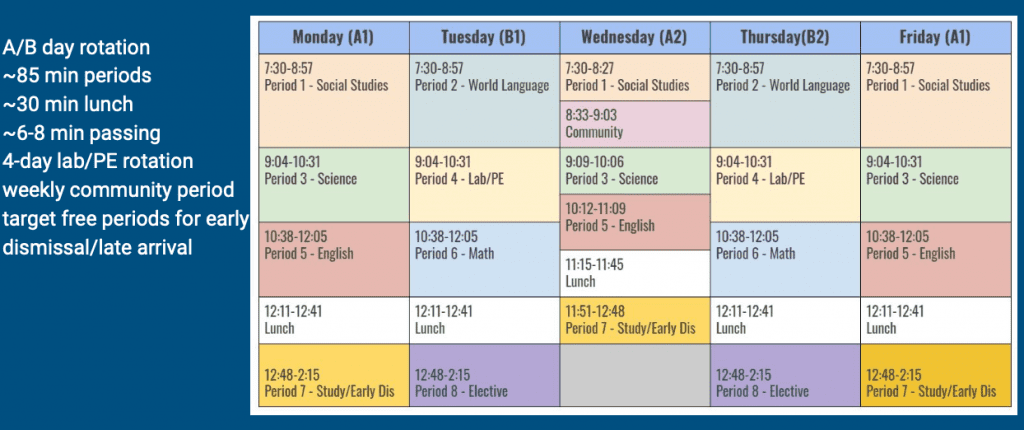
Sample high school block schedule
Remote learning
Vicinus also detailed the blueprint for remote learning – a plan that will be followed for students whose families opt not to send them to school. The remote learning plan would also be followed by all students in the district should schools buildings need to close due to a COVID-19 surge.
At the elementary school, the plan (see below) includes synchronous and asynchronous learning, and a daily rotation of arts.
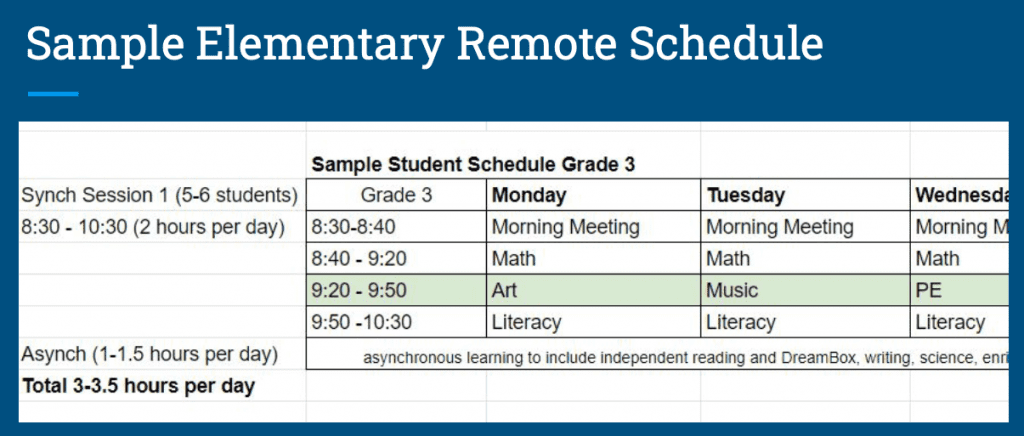
Sample elementary school remote schedule
The middle and high schools would have more synchronous learning than at the elementary schools, following a similar block schedule. Advisory and lab periods are included, but not all electives will be offered on high school online platforms, such as classes like auto repair or wood shop that require specialized equipment, or those for which enrollment is traditionally small such as Greek language.
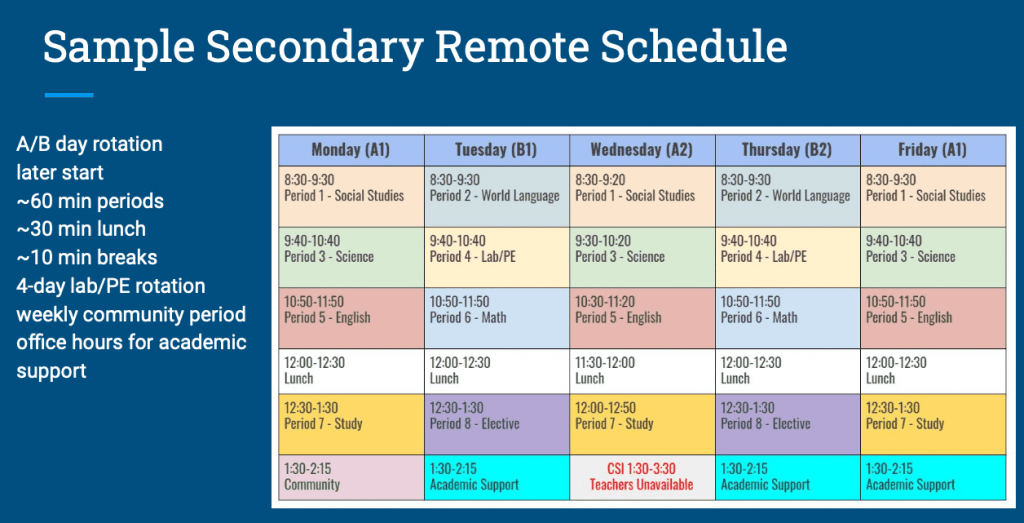
Sample secondary school remote schedule
Hybrid plan
If schools need to move to a hybrid plan (see below), where the in-school population must be reduced by 50%, students will alternate weeks they are in the buildings with remote learning, while maintaining continuous progress in the curriculum, Vicinus said. Groupings of students would be intentionally split to balance needs, and there will be shorter class periods and time built in for teachers to attend to students.
This won’t be just turning on the camera in the classroom, Vicinus said, because that doesn’t provide sufficient engagement.
For special populations where there is already a small footprint, such as the REACH program, those students would likely not move to a hybrid plan but rather continue to attend in-person classes, Vicinus said.
“[This type of] hybrid plan you won’t see anywhere else,” Moore said. He said Vicinus is an expert at scheduling, and the person that assists with scheduling questions statewide.
West Hartford’s hybrid plan represents a “re-centering and a rethinking,” Moore said. “If we do end up in a hybrid plan I feel really confident.”
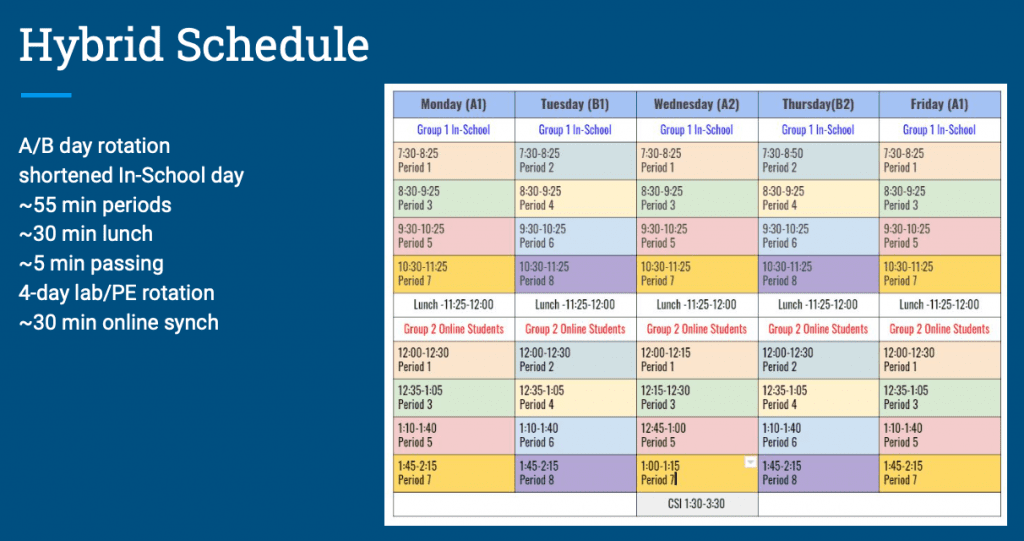
Sample secondary school hybrid schedule
Special populations
Director of Pupil Services Gretchen Nelson said that the program for the fall will build on what is already being implemented during summer school for students with IEP and 504 plans.
Some students are already being brought in on a one-to-one basis, she said, and there will likely be an extended orientation plan for the fall.
“Safety has driven much of the planning,” Nelson said, and federal law has provided some flexibility in how the student needs will be met while taking safety requirements into account.
While the majority of students with IEP and 504 plans will be able to continue to receive services in school, “there is a subset that will require a much more individualized and intensive training program to learn to follow guidelines and requirements and engage in a positive school experience,” she said.
Additional safety precautions may be needed for mask tolerance instruction.
Accommodations may include further reduced class sizes for specialized instruction, greater use of plexiglass, face shields and gloves, bins for individualized materials, and additional professional development. There may be exemptions for specific academic interventions, Nelson said.
If the district moves to the hybrid model, qualifying students will continue to receive in-person instruction depending on their specific needs.
Social and emotional learning
Nelson said there will be a focus on social and emotional learning to address not only the impact of the months-long school closure but also racial trauma. Multiple stakeholder groups, including Ari Steinberg representing the Board of Education, administrators, teachers, and parents, will be involved in the planning.
An expanded orientation will be recommended, as well as embedded social and emotional learning instruction, a review of discipline with a greater focus on restorative methods, and strengthened parent and school communication.
“The goal is to facilitate equitable access for all students,” Nelson said, and action plans are still under development.
Community outreach and equity, ‘One Community, One Year’
Roszena Haskins has had her title change from director of Diversity Enhancement to director of Equity Advancement (the department name changed as well), and has been responsible for putting equity at the core of the school reopening plans to ensure “full, safe, and equitable participation regardless of whether students are returning to brick and mortar schools or are remote.”
She said she is “charged with dismantling racism,” and is grateful to the “groundswell of public support” for her work, in part evidenced by those who spoke about equity, diversity, and inclusion during the public comment session. She said she didn’t feel defensive or offended because parent groups don’t think a meeting with her is sufficient. “I think most people, as I do, view you as a brave and bold change agent,” she said to Moore.
Haskins said her bodies of work involve equity-focused inquiries and implications across all program areas and operations. That includes maintaining a positive, safe, and healthy school climate because students can’t learn if they struggle with “fight or flight” reactions.
There needs to be anti-bias and social justice education across all grade levels to “see, and name, and challenge all forms of racism, discrimination, and oppression.”
Students need to know when, how, and where they can go for help.
Essential technologies must be available for remote learning, and Haskins said the district is much more well-equipped to distribute equipment, and provide access to free WiFi and a help desk, than they were in March and April. Home dynamics will also be considered.
One positive aspect of use of a virtual platform is the removal of barriers and constraints for teacher conferences, Haskins said.
Students who qualify for free or reduced lunch and are receiving in-person instruction will continue to have access to meals during the day.
Haskins’ second area of focus is developing a community-engaged outreach and communication plan.
“We recognize that this year will not be a smooth and easy one,” Haskins said.
The theme for the year is “One Community, One Year,” she said. “One community lifts us up and recognizes that there will be sacrifices we all have to make.” That community will include Open Choice students, and those who are attending West Hartford Public Schools half-day in conjunction with a magnet program.
The communication will be “multimedia, multilingual, multimodal, and interactive, she said. Work will be grounded in the recently-released equity and anti-racism statement.
There will be videos, and principals will give virtual tours of the buildings. “We know that there is angst,” she said, but this is one year and she is hopeful we can see some positive change come out of it.
Dr. Scott Ratchford, who has been the school psychologist at King Philip Middle School, will join Haskins’ Department of Equity Advancement to help focus on family and school partnership.
Staff and faculty
Rick Ledwith, executive director of Human Resources, said the majority of students are expected to return to class and at this point about 50 teachers have expressed concerns about returning to the classroom. Some are personally high risk, and others have household members who are at risk.
“We will make every effort to grant reasonable requests,” Ledwith said, regarding giving those individuals online teaching assignments. Ideally the number of staff who want accommodations will match the needs, he said.
In the next 6 1/2 weeks, the district will need to hire and onboard a few dozen teachers, and positions are now posted.
The state Department of Education has granted flexibility in finding teachers in high-need areas, Ledwith said, and will be allowing the use of daily substitutes who do not have bachelor’s degrees to supplement anticipated needs from increased teacher absences. Those positions will likely be filled by college students. Additional teaching assistants will be hired for each building.
Employees will be asked to monitor their own health every day, answering a series of questions. “If we answer yes to any question we have to stay home. Period,” he said. “Our plan only works if we continuously monitor our own health and stay home if we do not feel well.”
Those exposed or those who contract COVID-19 will be able to quarantine at home for 14 days with coverage under the Coronavirus Rights Act, without using up sick leave.
Travel and quarantine restrictions set by the state will be enforced in the schools, Ledwith added.
“We’ve talked a lot about student social and emotional well-being … these are stressful times for everyone and as adults we need to take care of ourselves,” said Ledwith. The EAP (Employee Assistance Plan) through Lexington Group will be offering programs emphasizing self-care and mindfulness.
Comments and questions, sports and testing
Moore thanked the experts in the district, adding how fortunate we are to be able to create a plan without needing to hire an outside consultant.
We are here to do everything we can, said Moore. “This year, one community, one message, one voice. That we come together, that we get better, and that we can do all we can to educate our kids the best we can.”
The team answered several questions from Board members, including about before and after care which is planned to continue as in previous years through outside providers, but following new protocols.
The status of sports will be coming from the CIAC, which will issue a ruling the first week of August, Morrow said. “I can see certain sports, I have difficulty seeing all of them. … I’m a big fan of cross country, space out and ‘Run Forest, run,” he said, but has a hard time seeing how football will be played.
Preparation is underway for fall sports, however, with some conditioning and notices regarding physicals being sent out.
Moore said the question has been asked about why all of the students and staff are not being tested. “I agree that I would love to, and I am hopeful that at some tie we will have a cheap spit test,” he said. But in West Hartford, since the start of the pandemic, there have been just over 8,800 tests given thus far. One round of testing for all students and staff would mean 11,000 tests. “You can’t just send 11,000 people to CVS,” he said.
The wholesale cost of a test is about $100, Moore said. He would love for parents to have their kids tested, love for teachers to get tested, but can’t mandate it.
Change in the calendar
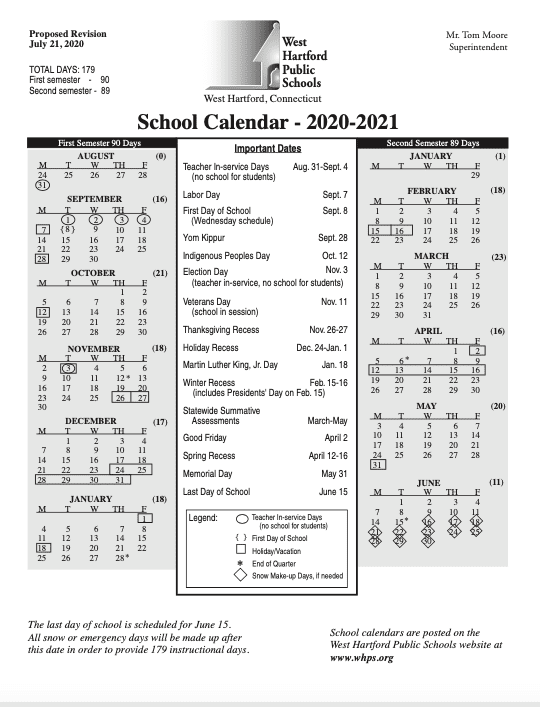
Revised West Hartford Public Schools calendar for the 2020-2021 school year.
Before diving into the “Reopening Schools” plan, the Board voted unanimously to approve a change to the 2020-2021 school calendar, moving the first day of school for students from Wednesday, Sept. 2 to Tuesday, Sept. 8 – the day after Labor Day.
The state’s Department of Education will permit schools to have 177 days rather than 180 days for students in the upcoming school year, provided that the reduction in classroom time is used for teacher training. “As we go back we need that time for training, for acclimating,” Moore told the Board.
Teachers will have a full week of in-service days (Aug. 31-Sept. 4) before students return, and that time will be used for professional development and orientation to new protocols. Additional professional development will continue on CSI Wednesdays.
Principals and educators will also be communicating with families during that week, and will also provide videos of what the interior of each school looks like so that everyone knows what to expect.
The first two days of school for students will be short days, utilizing the regular Wednesday dismissal schedule, Moore said.
Board Chair Deb Polun noted that the calendar as adopted Tuesday night allows for West Hartford Public Schools students to have 179 days of instruction, two more than permitted by the state for the year.
Like what you see here? Click here to subscribe to We-Ha’s newsletter so you’ll always be in the know about what’s happening in West Hartford! Click the blue button below to become a supporter of We-Ha.com and our efforts to continue producing quality journalism.



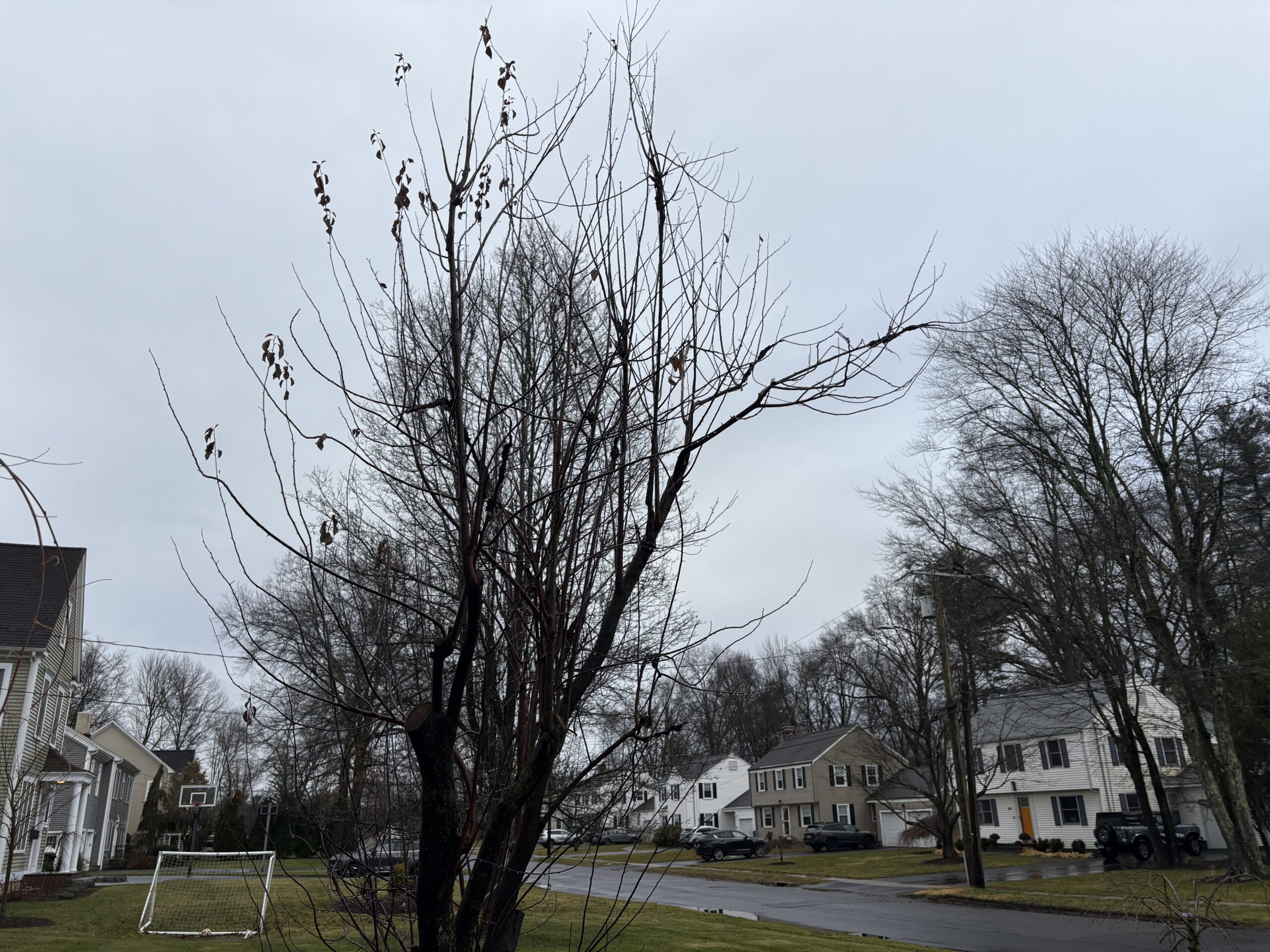
Thanks for taking such great care in unpacking this lengthy and hugely substantive meeting in this piece!
Thanks, Laurie! It was quite the project! ~Ronni
[…] who outlined the district’s three options to the Board of Education last week and sent families a more detailed report on Thursday, said he will do the best he can for the West […]
[…] half of the students at a time in the classrooms as the district begins the academic year under the hybrid plan detailed to the Board of Education and in an email to families last week, Superintendent Tom Moore said […]
[…] recognize that this year will not be a smooth and easy one,” Haskins said at the July 21 Board of Education meeting, when the district unveiled its three options for the upcoming school […]